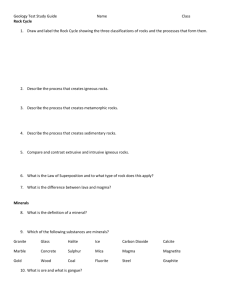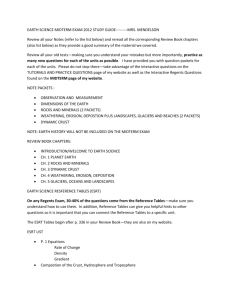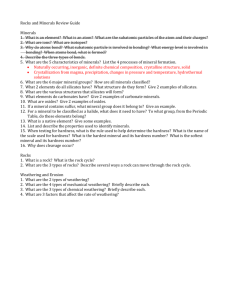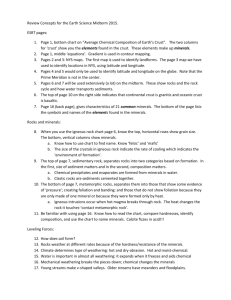First Hour Exam, Fall, 1996
advertisement
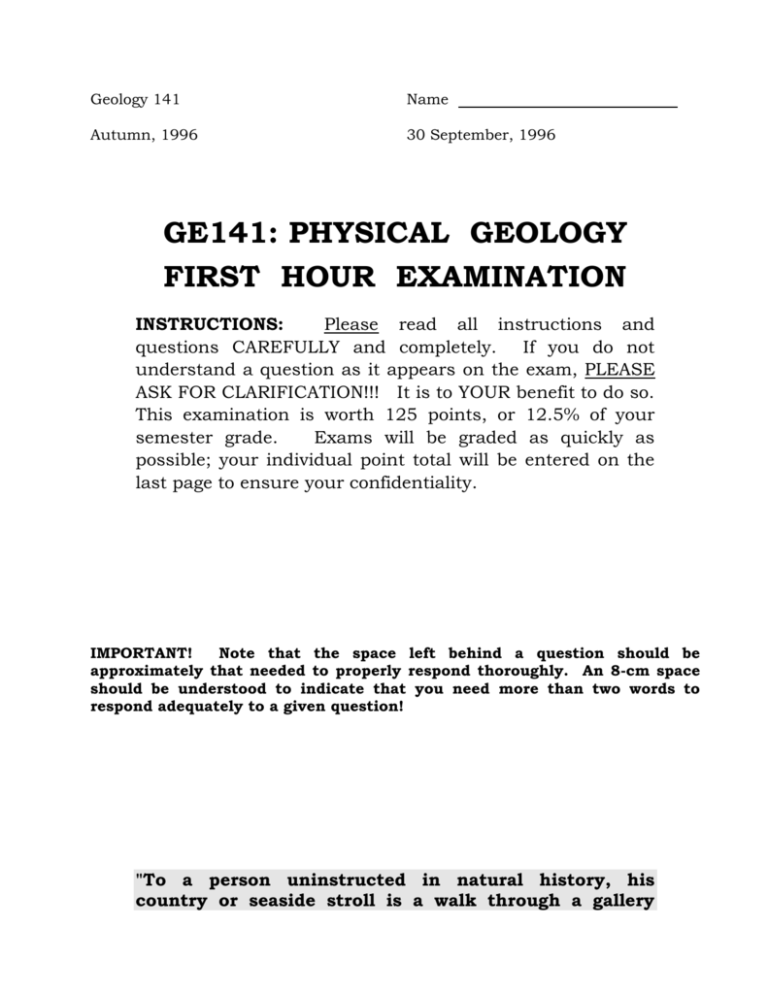
Geology 141 Name Autumn, 1996 30 September, 1996 GE141: PHYSICAL GEOLOGY FIRST HOUR EXAMINATION INSTRUCTIONS: Please read all instructions and questions CAREFULLY and completely. If you do not understand a question as it appears on the exam, PLEASE ASK FOR CLARIFICATION!!! It is to YOUR benefit to do so. This examination is worth 125 points, or 12.5% of your semester grade. Exams will be graded as quickly as possible; your individual point total will be entered on the last page to ensure your confidentiality. IMPORTANT! Note that the space left behind a question should be approximately that needed to properly respond thoroughly. An 8-cm space should be understood to indicate that you need more than two words to respond adequately to a given question! "To a person uninstructed in natural history, his country or seaside stroll is a walk through a gallery Geology 141: Fall, 1996 First Hour Exam ... Page 2 ... filled with wonderful works of art, nine-tenths of which have their faces to the wall." - T. H. Huxley Geology 141: Fall, 1996 First Hour Exam ... Page 3 ... Section I: Multiple choice. Please circle the letter of the response that is correct or that BEST answers the question or completes the statement. Please read each question and possible response carefully. There is ONLY ONE BEST ANSWER for each question. Each question is worth 3 points; this section is worth 75 out of the total of 125 for the exam. READ EACH QUESTION AND RESPONSE CAREFULLY! 1. The most abundant element by weight in the Earth as a whole is a. iron c. silicon e. oxygen b. nickel d. lead f. carbon 2. The most abundant element by weight in the CRUST of the Earth is a. iron c. silicon e. oxygen b. nickel d. lead f. carbon 3. The "Big Bang" that is believed to have created the entire known Universe is believed to have occurred a. about 15-25 billion years ago d. about 4-5 billion years ago b. about 15-25 million years ago e. about 4-5 million years ago c. about 15-25 thousand years ago f. about 4-5 thousand years ago 4. The Sun, the Earth and the rest of our solar system are believed to have originated a. about 15-25 billion years ago d. about 4-5 billion years ago b. about 15-25 million years ago e. about 4-5 million years ago c. about 15-25 thousand years ago f. about 4-5 thousand years ago 5. The transferric elements (copper, zinc, lead, silver, gold, nickel, etc.) were cited as evidence that our solar system is at least a second-generation star system. This is because a. these elements were only created in the Big Bang and took a long time to come together by gravitational attraction. b. these elements can only be created by the violent explosion that comes with the "death" of a pre-existing star. c. these elements are only created by global recycling caused by plate tectonic processes. d. these elements are derived only from meteorites and are found only in the very oldest rocks found on the Earth. 6. Evidence that supports the theories of continental drift and plate tectonics includes the facts that: a. continental margins seem to "fit" into a pattern, like puzzle pieces. b. the old rocks at these areas of presumed fit are the same on both sides. c. the fossils in the rocks across these areas of presumes fit are the same. d. the structures (folds, faults, etc.) in the rocks on opposite sides of what looks like a "fit" are the same. e. all of the above. f. none of the above 7. Most zones of plate divergence are beneath the oceanic floor in the midoceanic rise and ridge system. One of the places divergence is taking place that is not in a deep-sea setting is in a. Kamchatka d. Alaska Geology 141: Fall, 1996 First Hour Exam b. the Mississippi River valley e. the Gulf of California c. the Aleutian Islands ... Page 4 ... Geology 141: Fall, 1996 First Hour Exam ... Page 5 ... 8. The modern Himalaya exists because it a. lies over a major zone of divergence from rising mantle plumes. b. is where two continental blocks are being forced together. c. is being created by enormous volcanoes from oceanic plate subduction. d. is the remains of a giant asteroid that hit earth millions of years ago. 9. The mineral group that make up most (about 95%) of the Earth's crust is a. the native elements d. the oxides and hydroxides b. the sulfides e. the silicates c. the phosphates f. the carbonates 10. The non-silicate mineral group that is most abundant in the Earth's crust is a. the native elements d. the oxides and hydroxides b. the sulfides e. the sulfates c. the phosphates f. the carbonates 11. Iron and magnesium frequently substitute for each other in many mineral structures. This can take place only because a. they're both about the same abundance in the Earth's composition. b. their ions have the same charge and are almost the same size. c. they are only found in silicate minerals. d. they are the two most abundant elements in the Earth's crust. 12. Which of the following is NOT one of the essential criteria for a substance to be a mineral? a. it must be naturally occurring. b. it must have a constant internal structure. c. it must be an inorganic solid. d. it must have a constant chemical composition, or one that varies within set limits. e. it must contain silica. 13. The major mineral groups are distinguished from each other based on their a. chemistry c. structures b. physical properties d. rarity of occurrence 14. The silicates are subdivided into subgroups based on their a. chemistry c. structures b. physical properties d. rarity of occurrence 15. Two minerals that are believed to make up most of the upper mantle of the Earth, and which yield mafic magmas when melted, are a. quartz and feldspar c. olivine and pyroxene b. bauxite and clay d. iron and nickel 16. Oxide and sulfide minerals are extremely important because a. they make up most of the innermost part of the Earth. b. they provide many ores of metals, like iron, aluminum and copper. c. they are the major minerals that make up most rocks. d. they were created in the Big Bang and show us what the Universe was made up of before the Earth existed. 17. Mud on the ocean bottom is dragged down in a subduction zone. It is heated more and more as it descends into the Earth, and eventually it melts. The molten material hardens into rock. This solid material is now a. a metamorphic rock c. magma Geology 141: Fall, 1996 b. an igneous rock First Hour Exam d. a mantle plume ... Page 6 ... Geology 141: Fall, 1996 First Hour Exam ... Page 7 ... 18. The minerals that make up the phenocrysts in a rock with a porphyritic texture are almost always going to be a. minerals high in Bowen's Reaction Series. b. minerals low in Bowen's Reaction Series. c. minerals that aren't in Bowen's Reaction Series. d. any minerals at random from Bowen's Reaction Series. 19. The minerals that make up the phenocrysts in a rock with a porphyritic texture are almost always going to be a. silicates c. oxides or hydroxides b. sulfides d. carbonates 20. The most abundant volcanic rock in the entire world is a. obsidian c. granite b. basalt d. gabbro 21. Felsic igneous rocks are only found in areas of continental crust because a. the felsic magmas are formed by melting of continental crust. b. felsic magmas are formed from mantle material beneath continents. c. felsic rocks are usually plutonic, and plutonic rocks are only found on the continents. d. felsic rocks are all volcanic, and almost all volcanoes are on continents. 22. The most abundant plutonic rock in the continents of the world is a. andesite c. granite b. basalt d. gabbro 23. The rock-forming mineral that is most resistant to chemical weathering is a. hornblende d. olivine b. pyroxene e. Ca-plagioclase c. quartz 24. Whole working for a mining company in Tierra del Fuego, under contract to the United Nations, you have found a body of gabbro that has potential for a major mining venture. Your mapping indicates that this rock unit occurs at or near the Earth's surface over a total area of some 137 square kilometers. Drawing on the name of a local spring, in your report you name this rock unit the Agua Caliente a. Stock c. Laccolith e. Lopolith b. Sill d. Batholith f. Dike 25. The difference between chemical weathering and mechanical weathering is that a. chemical weathering is entirely caused by acid rain; only mechanical weathering is caused by natural processes. b. chemical weathering is the breakdown of rocks and minerals in place; mechanical weathering is the removal of those materials. c. there is no significant difference between chemical and mechanical weathering processes. d. chemical weathering creates new minerals from the ones that were there before; mechanical weathering changes the size of the pieces. Geology 141: Fall, 1996 First Hour Exam ... Page 8 ... Section II: Short answers, fill-ins, etc. Please respond to each question in the most appropriate fashion. Please make your responses concise and to the point, but thorough. There should be ample space provided for an adequate response. PLEASE write legibly; I CANNOT give any credit for responses I can't read! The number of points for each question is indicated in parentheses after the question; there are 50 points possible for this entire section. 26. Make a sketch of the gross internal structure of the Earth, showing each of the three major layers (and the two subdivisions of the one that IS so subdivided). Label by name each of the four units that show on your resulting sketch. (5 points) 27. (a) Sketch and label the structure of a silica tetrahedron (5 points) (b) What is the difference between silicon and silica? (5 points) Geology 141: Fall, 1996 First Hour Exam ... Page 9 ... Geology 141: Fall, 1996 First Hour Exam ... Page 10 ... 28. Sketch and label cross-sectional topographic profiles of a shield volcano and a typical stratovolcano. Why do they each show these different but characteristic shapes ? (10 points) 30. Fill in the blanks below with the names of each of the minerals that make up Bowen's Reaction Series (10 points; 1 point for each answer plus 1 bonus point for making any serious attempt). / / / / | | Geology 141: Fall, 1996 First Hour Exam | ... Page 11 ... Geology 141: Fall, 1996 First Hour Exam ... Page 12 ... 29. The ultimate fate of a magma, once it is formed, is determined by its (2) which in turn is a function of what three factors? (1) (1) (1) (= 5 points total) 31. On the maps on the following page (the maps are printed back-to-back), locate precisely each of the following localities or features. WHEN IT IS NECESSARY FOR CLARITY, use a sharp arrow drawn from your label to the feature. (10 points, 1 point each) All labels must be correctly spelled for credit! On the map of the U.S.: Oregon Arizona New Brunswick Georgia Washington, D. C. On the map of the world: Andes Mountains Red Sea Martinique Mediterranean Sea Kamchatka Grade on exam: __________________ out of 125 possible. 112.5 100.0 87.5 75.0 = = = = 90% 80% 70% (IF YOU ARE BELOW THIS, PLEASE SEE ME!) 60% NOTE: After exams are graded, I will return your exam ONLY to you. It will not be released to friends, roommates, your lab partner, or anyone else.

